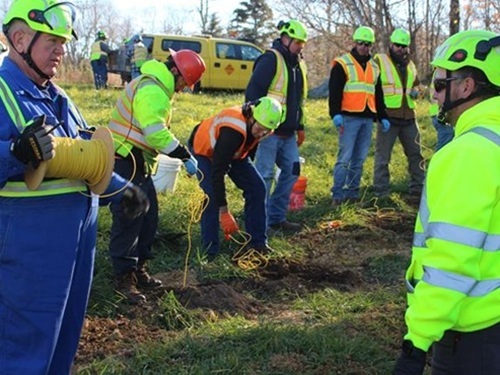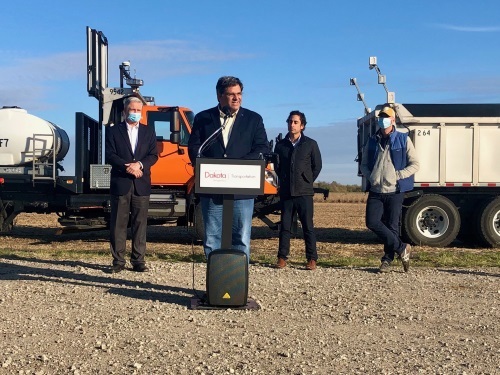The North Dakota Department of Transportation demonstrated its first “autonomous impact protection vehicle” at a test site event for federal and state officials on October 8; a truck designed to improve safety for work zone vehicle operators. Meanwhile, the agency inked a deal with Botlink InSites for its drone surveying and mapping needs.
[Above photo by the North Dakota DOT.]
The North Dakota DOT said that providing self-driving capabilities to trucks mounted with crash barriers improves work zone safety by removing the driver from the impact protection vehicle during normal operation. The agency noted that in 2019 there were 261 work zone related crashes on North Dakota highways, resulting in 64 injuries and two fatalities.

“This technology is one more tool that we will have available to enhance the safety of work zones in our state,” explained Bill Panos, North Dakota DOT’s director, in a statement.
“The NDOT remains committed to its Vision Zero initiative and our goal is to eliminate fatalities and serious injuries caused by motor vehicle crashes [and] we will continue to look for innovative ways to improve the safety of our state highway system,” he added.
The agency said it used a $241,687 grant from the Federal Highway Administration through its Accelerated Innovation Deployment program in January to purchase autonomous vehicle technology from Kratos Defense, in partnership with Royal Truck & Equipment, to convert an existing North Dakota DOT truck into a self-driving impact protection vehicle.

The agency added that this autonomous vehicle – which will be deployed in actual work zone protection operations in the spring of 2021 – will be monitored and controlled by a human operated lead vehicle and will automatically follow behind construction equipment without putting a driver in danger.
Concurrently on the technology front, the North Dakota DOT is contracting with Botlink InSites map generation software that uses images collected during drone flights to generate survey maps and 3D models with accurate dimensions.
The agency currently uses drones to deliver stockpiles of aggregate – rock, sand, and other building materials – by air and then processes that information to generate accurate inventory numbers.

BotSites noted that users can identify stockpiles of materials they want to measure within its mapping software; taking hours to calculate inventory, which used to take days on the ground, requiring workers to climb piles to obtain measurements.
“When we were looking for a new stockpile measurement software, the number one factor was accuracy. We compared the Botlink software with our survey team, and the results exceeded expectations,” explained Russ Buchholz, North Dakota DOT’s strategy and innovation director, in a statement. “The software is simple to use and returns results fast.”
 States
States
NCDOT Staff Participate in ‘Explosive’ Technical Training
December 19, 2025 States
States

